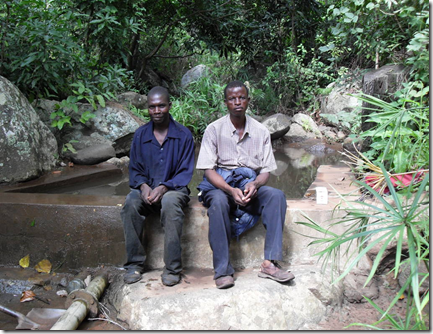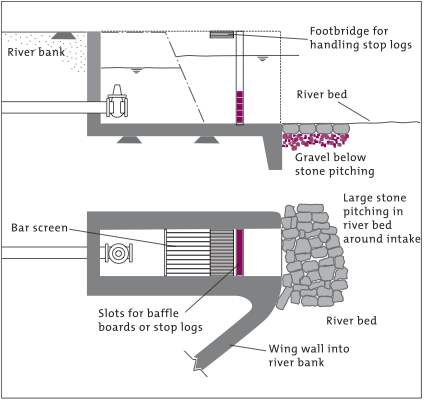वाटर पोर्टल / वर्षाजल संचयन / सतही जल / संरक्षित तटीय जलग्रहण
< वाटर पोर्टल / वर्षाजल संचयन | सतही जल| |
|
|
|
|
|
|
|
|

एक संरक्षित तटीय जलग्रहण नदी या झील के किनारे एक स्थायी जगह होती है, जहां से पानी किसी नहर या पंप तक जाने वाली पाइप से होकर बहती है. इस कुछ इस चरह बनाया जाता है कि यह बाढ़ से होने वाली क्षति का मुकाबला कर सके और गाद से होने वाली परेशानी को कम कर सके. तटीय जलग्रहण एक मजबूत संरचना होती है, जो अमूमन मजबूत कंकरीट से बनायी जाती है, और उसमें वॉल्व या स्लूइस बनाये जाते हैं ताकि अगर कुछ गाद जमा हो तो उसे बाहर निकाला जा सके. अक्सर, एक संरक्षित तटीय जलग्रहण नदी में एक वेयर से जुड़ा रहता है ताकि पानी एक निर्धारित स्तर तक ही सीमित रहे, उसमें एक सैंड ट्रैप भी होता है ताकि मिट्टी नीचे जमा हो सके, और एक नाली होती है ताकि अधिक पानी बाहर निकल सके. नदी का पानी तटीय जलग्रहण में स्क्रीन के जरिये अंदर आता है, और अधिक होने पर नाली के जरिये बाहर निकल जाता है. कई दफा, संरक्षित तटीय जलग्रहण एक डैम और बाहर निकालने वाली नाली से जुड़ा होता है जो नदी की धारा को फ्लश करने देता है.
उचित परिस्थितियां
- जलग्रहण का मुख्य उद्देश्य पानी की नियमित आपूर्ति सुनिश्चित करना है, जिसे स्थानीय परिस्थितियों के हिसाब से ढाला जा सकता है.
- विशाल नदियां जिनका जलस्तर ऊपर-नीचे होता रहता है, उनसे बचना चाहिये. ध्यान रखना चाहिये कि जलग्रहण को न्यूनतम जलस्तर से ऊपर कभी न रखें.
Resilience to changes in the environment
Drought effects on cement
Effects of drought: When water levels are low, problems can occur if the concrete was badly made, which also leads to cracked linings (e.g. in tanks, dams, waterways, wells, and other structures).
Underlying causes of effects: Less water used for curing; Impure water used for mixing.
To increase resiliency of WASH system: Ensure adequate mixing, ratios, purity of ingredients; Minimize water content in mixture; Ensure adequate curing.
More information on managing drought: Resilient WASH systems in drought-prone areas.
Construction, operations and maintenance
— Operation of a protected side-intake system is usually carried out by a caretaker;
— a valve or a sluice may have to be adjusted daily, the inlet to the channel or pump checked for obstructing debris, and any damage repaired;
— preventive maintenance, including painting the screens and other metal parts, such as sluices or valves;
— the intake canal and silt trap may have to be de-silted, debris cleaned from the screens regularly, and damaged screens should be welded;
— during the rainy season, the inlet may need checking and cleaning more frequently;
— any erosion of the river bank or bed must be repaired immediately with boulders, rocks, sandbags, etc.;
— cracks in the concrete structure should be repaired every year;
— annual cleaning and major repairs (these may require the assistance of the water users);
— after flooding, cleaning may be necessary.
Brikke and Bredero, in their publication Linking technology choice with operation and maintenance in the context of community water supply and sanitation: A reference document for planners and project staff, recommend the following O&M activities in the chart below:
Potential problems
— clogging by silt or debris;
— the side-intake system may be undermined by river currents;
— the river or lake water may be polluted.
Manuals, videos, and links
- Surface water intake and small dams. Chapter 11. Revised by Nhamo Masanganise.
Acknowledgements
- Brikke, François, and Bredero, Maarten. Linking technology choice with operation and maintenance in the context of community water supply and sanitation: A reference document for planners and project staff or (alternative link). World Health Organization and IRC Water and Sanitation Centre. Geneva, Switzerland 2003.
- CARE Nederland, Desk Study: Resilient WASH systems in drought-prone areas. October 2010.

